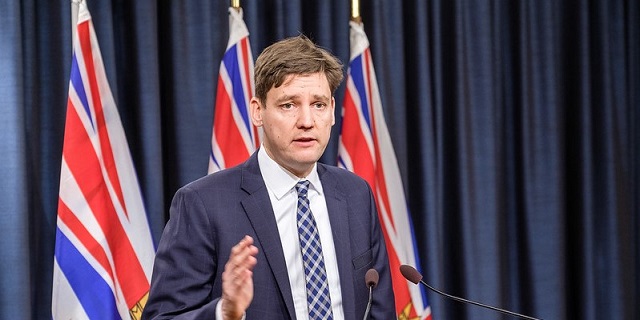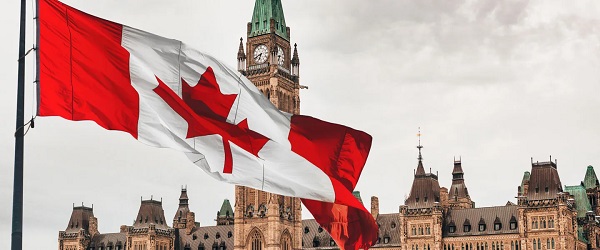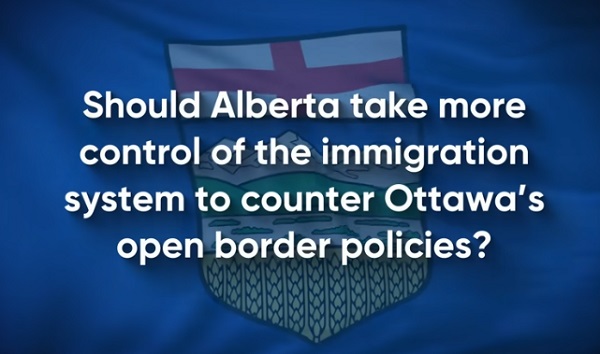Fraser Institute
Yes, B.C.’s Land Act changes give First Nations veto over use of Crown Land

From the Fraser Institute
By Bruce Pardy
Nathan Cullen says there’s no veto. Cullen, British Columbia’s Minister of Water, Land, and Resource Stewardship, plans to give First Nations joint decision-making authority over Crown land. His NDP government recently opened consultations on its proposal to amend the B.C. Land Act, under which the minister grants leases, licences, permits, rights-of-way and land sales. The amendments will give legal effect to agreements with Indigenous governing bodies. Those agreements will share decision-making power “through joint or consent models” with some or all of B.C.’s more than 200 First Nations.
Yes, First Nations will have a veto.
Cullen denies it. “There is no veto in these amendments,” he told the Nanaimo News Bulletin last week. He accused critics of fearmongering and misinformation. “My worry is that for some of the political actors here on the right, this is an element of dog-whistle politics.”
But Cullen has a problem. Any activity that requires your consent is an activity over which you have a veto. If a contract requires approval of both parties before something can happen, “no” by one means “no” for both. The same is true in other areas of law such as sexual conduct, which requires consent. If you withhold your consent, you have vetoed the activity. “Joint decision-making,” “consent,” and “veto” come out to the same thing.
Land use decisions are subject to the same logic. The B.C. government will give First Nations joint decision-making power, when and where agreements are entered into. Its own consultation materials say so. This issue has blown up in the media, and the government has hastily amended its consultation webpage to soothe discontent (“The proposed amendments to the Land Act will not lead to broad, sweeping, or automatic changes (or) provide a ‘veto.’”) Nothing to see here folks. But its documentation continues to describe “shared decision-making through joint or consent models.”
These proposals should not surprise anyone. In 2019, the B.C. legislature passed Bill 41, the Declaration of the Rights of Indigenous Peoples Act (DRIPA). It requires the government to take “all measures necessary” to make the laws of British Columbia consistent with the United Nations Declaration on the Rights of Indigenous People (UNDRIP).
UNDRIP is a declaration of the U.N. General Assembly passed in 2007. It says that Indigenous people have “the right to the lands, territories and resources which they have traditionally owned, occupied or otherwise used or acquired… to own, use, develop and control.”
On its own, UNDRIP is non-binding and unenforceable. But DRIPA seeks to incorporate UNDRIP into B.C. law, obligating the government to achieve its aspirations. Mere consultation with First Nations, which Section 35 of the Constitution requires, won’t cut it under UNDRIP. Under Section 7 of DRIPA, agreements to be made with indigenous groups are to establish joint decision-making or to require consent of the Indigenous group. Either Cullen creates a First Nations veto or falls short of the goalposts in DRIPA. He is talking out of both sides of his mouth.
Some commentators warned against these dangers long ago. For example, shortly after DRIPA was passed in 2019, Vancouver lawyer Robin Junger wrote in the Vancouver Sun, “It will likely be impossible for government to live up to the expectations that Indigenous groups will now reasonably hold, without fundamentally affecting the rights and interests of third parties.” Unfortunately, few wanted to tackle that thorny question head on at the time. All three political parties in B.C. voted in favour of DRIPA, which passed unanimously.
For a taste of how Land Act changes could work, ask some B.C. residents who have private docks. In Pender Harbour, for instance, the shishalh Nation and the province have jointly developed a “Dock Management Plan” to try and impose various new and onerous rules on private property owners (including red “no go” zones and rules that will make many existing docks and boat houses non-compliant). Property owners with long-standing docks in full legal compliance will have no right to negotiate, to be consulted, or to be grandfathered. Land Act amendments may hardwire this plan into B.C. law.
Yet Cullen insists that no veto will exist since aggrieved parties can apply to a court for judicial review. “[An agreement] holds both parties—B.C. and whichever nation we enter into an agreement (with)—to the same standard of judicial review, administrative fairness, all the things that courts protect when someone is going through an application or a tendering process,” he told Business in Vancouver.
This is nonsense on stilts. By that standard, no government official has final authority under any statute. All statutory decisions are potentially subject to judicial review, including decisions of Cullen himself as the minister responsible for the Land Act. He doesn’t have a veto? Of course he does. Moreover, courts on judicial review generally defer to statutory decision-makers. And they don’t change decisions but merely send them back to be made again. The argument that First Nations won’t have a veto because their decisions can be challenged on judicial review is legal jibber jabber.
When the U.N. passed UNDRIP in 2007, people said they can’t be serious. When the B.C. legislature passed DRIPA in 2019, people said they can’t be serious. The B.C. government now proposes to give First Nations a veto over the use of Crown land. Don’t worry, they can’t be serious.
Author:
Business
Carney government should recognize that private sector drives Canada’s economy

From the Fraser Institute
An important lesson of the Justin Trudeau era is that economic prosperity cannot be built on the back of an expanding government sector, higher deficits and ever-greater political tinkering with the economy. It’s time for something different.
At the half-way point of what’s shaping up to be a turbulent 2025, how is Canada’s economy faring?
By any measure, the past six months have been a bumpy ride. The Canadian economy lost momentum over much of last year, with economic growth cooling, job creation slowing, and the unemployment rate creeping higher. Then as 2025 began came the shock of Donald Trump’s tariffs and—more recently—the outbreak of increased military conflict in the Middle East.
Amid these developments, indices of global policy and business uncertainty have risen sharply. This creates a difficult backdrop for Canadian businesses and for the re-elected Liberal government led by Prime Minister Carney.
Economic growth in the first quarter of 2025 received a temporary boost from surging cross-border trade as companies in both Canada and the United States sought to “front-run” the risk of tariffs by increasing purchases of manufactured and semi-finished goods and building up inventories. But trade flows are now diminishing as higher U.S. and Canadian tariffs come into effect in some sectors and are threatened in others. Meanwhile, consumer confidence has plunged, household spending has softened, housing markets across most of Canada are in a funk, and companies are pausing investments until there’s greater clarity on the future of the Canada-U.S. trade relationship.
Some forecasters believe a recession will unfold over the second and third quarters of 2025, as the Canadian economy absorbs a mix of internal and external blows, before rebounding modestly in 2026. For this year, average economic growth (after inflation) is unlikely to exceed 1 per cent, down from 1.6 per cent in 2024. The unemployment rate is expected to tick higher over the next 12-18 months. Housing starts are on track to drop, notwithstanding a rhetorical political commitment to boost housing supply in Ottawa and several provincial capitals. And business investment is poised to decline further or—at best—remain flat, continuing the pattern seen throughout the Trudeau era. Even this underwhelming forecast is premised on the assumption that ongoing trade tensions with the U.S. don’t spiral out of control.
How should Canadian policymakers respond to this unsettled economic picture? We do not face a hit to the economy remotely equivalent to that generated by the COVID pandemic in 2020-21, so there’s no argument for additional deficit-financed spending by governments—particularly when public debt already has been on a tear.
For the Carney government, the top priority must be to lessen uncertainty around Canada-U.S. trade and mitigate the threat of sweeping tariffs as quickly as possible. Until this is accomplished, the economic outlook will remain dire.
A second priority is to improve the “hosting conditions” for business growth in Canada after almost a decade of stagnant living standards and chronically weak private-sector investment. This will require significant reforms to current taxation, regulatory and project assessment policies aimed at making Canada a more attractive location for companies, investors and entrepreneurs.
An important lesson of the Justin Trudeau era is that economic prosperity cannot be built on the back of an expanding government sector, higher deficits and ever-greater political tinkering with the economy. It’s time for something different.
Policymakers must recognize that Canada is a largely market-based economy where the private sector rather than government is responsible for the bulk of production, employment, investment, innovation and exports. This insight should inform the design and delivery of economic policymaking going forward.
Automotive
Federal government should swiftly axe foolish EV mandate

From the Fraser Institute
Two recent events exemplify the fundamental irrationality that is Canada’s electric vehicle (EV) policy.
First, the Carney government re-committed to Justin Trudeau’s EV transition mandate that by 2035 all (that’s 100 per cent) of new car sales in Canada consist of “zero emission vehicles” including battery EVs, plug-in hybrid EVs and fuel-cell powered vehicles (which are virtually non-existent in today’s market). This policy has been a foolish idea since inception. The mass of car-buyers in Canada showed little desire to buy them in 2022, when the government announced the plan, and they still don’t want them.
Second, President Trump’s “Big Beautiful” budget bill has slashed taxpayer subsidies for buying new and used EVs, ended federal support for EV charging stations, and limited the ability of states to use fuel standards to force EVs onto the sales lot. Of course, Canada should not craft policy to simply match U.S. policy, but in light of policy changes south of the border Canadian policymakers would be wise to give their own EV policies a rethink.
And in this case, a rethink—that is, scrapping Ottawa’s mandate—would only benefit most Canadians. Indeed, most Canadians disapprove of the mandate; most do not want to buy EVs; most can’t afford to buy EVs (which are more expensive than traditional internal combustion vehicles and more expensive to insure and repair); and if they do manage to swing the cost of an EV, most will likely find it difficult to find public charging stations.
Also, consider this. Globally, the mining sector likely lacks the ability to keep up with the supply of metals needed to produce EVs and satisfy government mandates like we have in Canada, potentially further driving up production costs and ultimately sticker prices.
Finally, if you’re worried about losing the climate and environmental benefits of an EV transition, you should, well, not worry that much. The benefits of vehicle electrification for climate/environmental risk reduction have been oversold. In some circumstances EVs can help reduce GHG emissions—in others, they can make them worse. It depends on the fuel used to generate electricity used to charge them. And EVs have environmental negatives of their own—their fancy tires cause a lot of fine particulate pollution, one of the more harmful types of air pollution that can affect our health. And when they burst into flames (which they do with disturbing regularity) they spew toxic metals and plastics into the air with abandon.
So, to sum up in point form. Prime Minister Carney’s government has re-upped its commitment to the Trudeau-era 2035 EV mandate even while Canadians have shown for years that most don’t want to buy them. EVs don’t provide meaningful environmental benefits. They represent the worst of public policy (picking winning or losing technologies in mass markets). They are unjust (tax-robbing people who can’t afford them to subsidize those who can). And taxpayer-funded “investments” in EVs and EV-battery technology will likely be wasted in light of the diminishing U.S. market for Canadian EV tech.
If ever there was a policy so justifiably axed on its failed merits, it’s Ottawa’s EV mandate. Hopefully, the pragmatists we’ve heard much about since Carney’s election victory will acknowledge EV reality.
-

 Also Interesting1 day ago
Also Interesting1 day ago9 Things You Should Know About PK/PD in Drug Research
-

 Business2 days ago
Business2 days ago‘Experts’ Warned Free Markets Would Ruin Argentina — Looks Like They Were Dead Wrong
-

 Business2 days ago
Business2 days agoWEF-linked Linda Yaccarino to step down as CEO of X
-

 Business1 day ago
Business1 day agoCannabis Legalization Is Starting to Look Like a Really Dumb Idea
-

 Business1 day ago
Business1 day agoCarney government should recognize that private sector drives Canada’s economy
-

 Bruce Dowbiggin1 day ago
Bruce Dowbiggin1 day agoThe Covid 19 Disaster: When Do We Get The Apologies?
-

 Media1 day ago
Media1 day agoCBC journalist quits, accuses outlet of anti-Conservative bias and censorship
-

 Alberta1 day ago
Alberta1 day agoFourteen regional advisory councils will shape health care planning and delivery in Alberta







